|
|
 |
TREKCORE >
GAMING >
STARFLEET COMMAND III > Ships and
Stations
Below you will
find info on the ships and stations in Starfleet Command 3.
The image for each ship is a view from the top, and
sometimes does not convey what the ship/station looks like
in 3D.
This page is
divided into the following sections:
UNITED FEDERATION OF PLANETS
ROMULAN STAR EMPIRE
KLINGON EMPIRE
BORG EMPIRE
OTHER VESSELS
|
UNITED FEDERATION OF PLANETS |
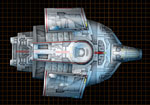 |
The
Defiant-class is the first pure warship designed by
Starfleet and is the basis for many of the technologies
found in ships that would later come out of the advanced
starship initiative. The Defiant was rushed into
production after the first Borg attack and was designed
specifically to counter any future Borg incursions. As
time passed and the Borg did not reappear, work on the
vessel slowed. Its prototype was eventually assigned to
Deep Space 9 in order to aid in skirmishes with the
Dominion. When the Borg reappeared in 2373, the
Defiant-class was put to its original use and was
invaluable to the defense of Sector 001. The Defiant is
heavily armored and extremely maneuverable, allowing it
to infiltrate enemy territory at high warp. Today the
vessel serves many functions in Starfleet, mostly
military in nature.
Notable vessels in the Defiant-class include the U.S.S.
Defiant, NX-74205, assigned to station Deep Space 9,
which fought several key battles and was eventually
destroyed in the Dominion War. The U.S.S. Sao Paulo was
then assigned to Deep Space 9 as a replacement. By
special Starfleet dispensation, the ship was renamed
Defiant and given that ship’s former registry number.
|
 |
|
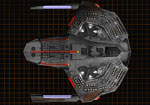 |
The
Saber-class starship was introduced in the late 24th
century as part of Starfleet’s initiative to create a
new generation of ships to combat any future Borg
incursions. Designed primarily as a reconnaissance
vessel, the Saber’s high maneuverability and versatility
made it a reliable combat vessel in the defense against
the Borg invasion of Earth, and later the Dominion War.
The Saber’s compact design allows it to maintain faster
impulse speeds and turn more tightly than other larger
ships. The Saber needs this speed, as its design
features a weaker hull than other Starfleet vessels and
less shield power than most other ships.
Notable Saber-class vessels include the U.S.S Yeager,
NCC-61947, which defended Sector 001 against Borg
invasion in 2373. |
| |
|
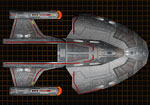 |
The
Norway-class Starship was designed in the same Starfleet
initiative that produced the Saber-class “Frigate.” The
Norway was intended primarily as an advanced escort
vessel and was engineered with an eye toward defeating
any future Borg invasions. Completed in time to assist
the fleet against the Borg incursion into Sector 001 in
2373, the Norway proved itself as a versatile combat
vessel and saw action again in the Dominion War. The
Norway is fitted with heavier armor and more weapons
than the smaller Saber-class “Frigate,” but sacrifices
some of the speed and maneuverability of that class. For
this reason, the Norway is used mainly for low-risk
exploration and escort missions.
Notable Norway-class vessels include the U.S.S. Budapest,
NCC-64923, which helped fight back the Borg in 2373. |
| |
|
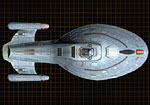 |
The
Intrepid-class starship features numerous new
technologies that mark a change in Starfleet’s design
philosophy. Instead of building ever-larger, more
complicated ships, the new design initiative focused on
smaller, more compact and streamlined vessels. The
Intrepid is the first Starfleet vessel equipped with a
computer system based on bio-neural gel packs, allowing
for advanced processing at enhanced speed. The Intrepid
also pioneered technology allowing a starship to land on
a planet with minimal system damage. Another design
breakthrough introduced with the Intrepid was variable
geometry warp nacelles, which are capable of configuring
to maximize the efficiency of the ship’s warp core to
provide maximum warp for less power than on a regular
warp drive.
Notable Intrepid-class vessels include the U.S.S. Voyager,
NCC-74656. Lost on its first mission, Voyager was later
discovered to have been transported into the Delta
Quadrant. While there, the ship made more first contacts
than any ship in Starfleet history and made significant
research into the workings of the Intrepid class.
Voyager returned to the Alpha Quadrant in 2377. |
| |
|
 |
The
Akira-class vessel was designed as one of Starfleet’s
first combat-focused starships. Its design was
originally used merely as a testing bed for advanced
weapons systems being developed during the build-up of
tensions between the Federation and the Cardassian
Empire. After the battle of Wolf 359, Starfleet hurried
the prototype into actual production, sensing the need
for more ships designed for combat instead of
exploration. The vessel proved itself during the second
Borg attack and later during the Dominion War. Although
its primary focus is tactical, the Akira can also be
used for a wide variety of other purposes.
Notable Akira-class vessels include the U.S.S.
Thunderchild, NCC-63549, which took part in the defense
of Sector 001 against Borg invasion in 2373. |
| |
|
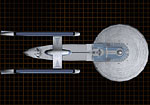 |
|
EXCELSIOR - Heavy Cruiser |
The
Excelsior-class was originally designed and built in the
23rd century during Starfleet’s early experiments with
transwarp drive. Transwarp was eventually proven
unviable, and the Excelsior-class was refitted with a
standard warp drive. An advanced ship for its time, the
Excelsior has been continually refitted and upgraded to
serve alongside Starfleet’s more advanced vessels. It
still sees heavy use today, although usually in some of
the less glamorous assignments. Due to its upgraded
weapons systems, the Excelsior is still a formidable
opponent in combat situations.
Notable Excelsior-class vessels include the prototype
U.S.S. Excelsior, NCC-2000, under the command of Hikaru
Sulu, which played a key role in the defense of the Khitomer Conference in 2293, and the U.S.S. Enterprise,
NCC-1701-B, the third starship to bear the name. |
| |
|
 |
| NEBULA
- Heavy Battlecruiser |
The
Nebula-class vessel was originally designed as a
lower-cost alternative to the Galaxy class. The two
vessels share many of the same advanced components,
systems and design features, but the Nebula’s integrated
hull structure and modest scale make it more
cost-effective for mass production than its larger
Galaxy-class cousin. In addition, the Nebula features a
large dorsal equipment module. This module allows the
Nebula to be alternately configured for either research
or combat by housing either an advanced sensor package
or weapons platform. Its wide array of uses makes the
Nebula one of the most versatile ships in Starfleet,
although its relatively weak armor keeps it from seeing
the front lines as often as more combat-oriented
vessels.
Notable Nebula-class vessels include U.S.S. Endeavor,
NCC-71805, which participated in the Romulan blockade
during the Klingon civil war, and the U.S.S. Phoenix,
NCC-65420. |
| |
|
 |
The
Galaxy was designed as the Federation’s primary research
and exploration vessel and is among the most advanced
and powerful vessels in Starfleet, once serving as the
flagship of the fleet. The Galaxywas designed to fill
any role given to it, from combat to first contact
duties, and is the first ship in the fleet to feature
extensive civilian quarters, allowing families to be
raised onboard the ship. Its sheer size makes it ideal
for emergency evacuation and relocation duties. The
Galaxy-class is also one of the most expensive ships
ever constructed by the fleet, and, as a result, its
production is limited. The smaller Nebula-class was
designed as a lower-cost alternative to the Galaxy.
Notable Galaxy-class vessels include the U.S.S.
Enterprise, NCC-1701-D, the flagship of the Federation
under the command of Captain Jean-Luc Picard until its
destruction in the Veridian system in 2371. |
| |
|
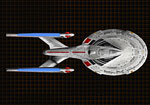 |
The
Sovereign-class vessel is the most advanced ship in use
in Starfleet today, and functions as the current
flagship of the Federation. Featuring elements
researched as a part of the advanced starship initiative
in order to react to future Borg incursions, the
Sovereign (at nearly 700 meters in length) is the
largest and most impressive starship in the fleet.
Designed as a multi-function vessel, the Sovereign is
equipped with advanced weapons platforms and upgraded
sensor and shield systems. It is effective both as an
exploratory and research vessel, as well as a front-line
combat vessel.
Notable Sovereign-class vessels include the Federation
flagship U.S.S. Enterprise, NCC 1701-E, which stopped
the Borg from interfering with Earth’s timeline after
the Borg incursion in 2373, and the U.S.S. Sovereign,
NCC-73811, which served a major role in the Kessok
Incident. |
| |
|
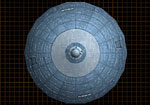 |
There
are three types of Federation starbases. Each of
them have the same overall design, but differ in size
and purpose:
BASESTATION - A small, fixed installation.
Basestations are lightly armed and shielded, and are
usually constructed in areas where a permanent facility
is needed but a full combat-ready station is not.
STARBASE
- A large, fixed installation. Starbases serve to
establish control points in space and to provide major
staging areas from which to deploy starships. Starbases
are heavily armed, heavily protected, dangerous
facilities.
BATTLESTATION - Larger than a Basestation, the
Battlestation is more heavily armed and protected.
Battlestations are usually constructed in areas where
some combat may be expected, but the expense of a full
Starbase is not required. |
| |
|
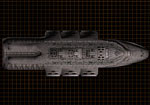 |
The
freighter is used for transport of civilians and goods. |
| |
|
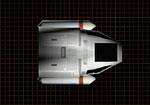 |
The
standard short ranged craft used by the Federation.
Shuttles can carry up to 6 personnel and are generally
used for short-range transport. |
 |
The
Raptor-class vessel is a child of the same advanced
design initiative that brought the Vales into the
Romulan military. While the Vales was designed primarily
as a combat vessel, the Raptor was to be a more rounded
ship. In addition to advanced weaponry, the Raptor
features high-bandwidth sensor packages and upgraded
onboard research facilities, making it a very effective
exploration and research vessel. Capable of extended
periods away from base due to its low-bleed singularity
core and extensive crew facilities, the Raptor is ideal
for the more secretive missions of the Romulan military.
Notable Raptor-class vessels include the I.R.W. Antares,
which aided in the downing and eventual salvage of a
Borg scout vessel in the Relik sector, thwarting a Borg
incursion and allowing the Romulans an insight into
numerous new technologies. |
 |
|
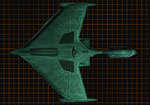 |
The
D’Deridex-class “Warbird” is the most powerful vessel in
the Romulan Empire. Although “Warbirds” were in service
long before the more advanced Romulan weapons and
systems were developed, the vessels are constantly
upgraded to keep their technology current. The “Warbird”
fills many duties in the fleet, including combat,
exploration and science missions. The “Warbird’s”
enormous size (nearly twice as long as a Federation
Galaxy-class vessel) houses research labs,
reverse-engineering terminals, and intelligence
gathering equipment which make it instrumental in
Romulan combat operations, both direct and covert.
Notable Warbird-class vessels include the I.R.W. D’Trell,
leader of the Romulan division of the Alpha Quadrant
alliance in the attack on the Chin’Toka system in 2374. |
| |
|
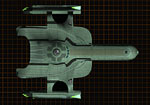 |
| HAWK
- Heavy Battlecruiser |
After
the first indications of the coming Borg threat along
the Neutral Zone in 2364, the Romulan military began
researching advanced systems and ship designs in an
effort to upgrade their military against future
incursions. The project was accelerated after the
Romulans obtained intelligence reports on the full
capabilities of the Borg after the battle of Wolf 359,
and the Hawk was the first ship to emerge from the new
design initiative. Taking numerous cues from the
powerful Romulan “Warbird” in its design, the Hawk is a
well-armed and maneuverable strike vessel with cloaking
capabilities designed for heavy combat duties.
Notable Vales-class vessels include the I.R.W. Cathex, the
ship captained by the legendary Commander Astran, which
disappeared in 2372. |
| |
|
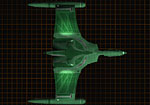 |
The
Shrike-class is a light cruiser designed primarily as a
scout vessel. As conflicts along the Romulan-Federation
Neutral Zone tapered off, the Romulan military realized
that assigning its heavier ships to the region was a
waste of resources. They set about designing a smaller
vessel that could fill the patrol duties and yet still
defend itself adequately if the need arose. The Shrike,
which requires a minimal crew and is relatively cheap to
produce, is the result of this design. The vessel is
also equipped with a standard Romulan cloaking device,
allowing it to investigate disturbances in secret.
Notable Shrike-class vessels include the I.R.W. Soren,
which was instrumental in detecting and eliminating the
presence of Cardassian minelayers along the Neutral Zone
during the Dominion War. |
| |
|
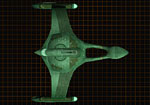 |
After
the Talon proved itself as a versatile high-speed combat
vessel, the need arose for a version of the ship more
capable of defending itself for use in high-risk
insertion and escort missions. The result was the
Falcon-class, which is based on the same hull design as
the Talon, but features additional weapon mounts to make
the vessel a more formidable opponent if it is unable to
use its speed and cloaking device to escape. The added
systems lower the overall top speed and maneuverability
of the ship, but raise its overall survivability
significantly.
Notable Falcon-class vessels include the I.R.W. Taval,
which leads the Romulan fleet’s prestigious Omicron Fast
Attack Wing. |
| |
|
 |
The
Talon-class “Frigate” fills the fast-attack role in the
Romulan fleet. Extremely quick and very agile, the ship
is capable of out-maneuvering any vessel it comes
across. The Talon was designed primarily to avoid combat
in favor of stealth, using its standard cloaking device
to penetrate enemy fortifications and extract spies or
sabotage enemy defenses. Although lightly armored and
featuring relatively weak weapons, the Talon is a
formidable and often deadly opponent.
Notable Talon-class vessels include the I.R.W. Deunan,
which single-handedly defended the Romulan Briareos
Outpost from attack by 3 rogue Klingon B’Rel-class
“Birds of Prey” in 2371. |
| |
|
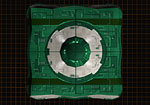 |
There are
three types of Romulan starbases. Each of them
have the same overall design, but differ in size and
purpose:
BASESTATION - A small, fixed installation.
Basestations are lightly armed and shielded, and are
usually constructed in areas where a permanent facility
is needed but a full combat-ready station is not.
STARBASE
- A large, fixed installation. Starbases serve to
establish control points in space and to provide major
staging areas from which to deploy starships. Starbases
are heavily armed, heavily protected, dangerous
facilities.
BATTLESTATION - Larger than a Basestation, the
Battlestation is more heavily armed and protected.
Battlestations are usually constructed in areas where
some combat may be expected, but the expense of a full
Starbase is not required. |
| |
|
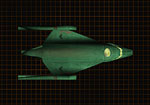 |
The
standard short ranged craft used by the Romulan Star
Empire. Shuttles can carry up to 6 personnel and are
generally used for short-range transport. |
| |
|
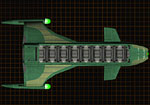 |
The
common freighter used in the Romulan Star Empire. |
 |
The
Negh’Var is the flagship of the Klingon Defense Force,
and the largest and most powerful ship in the Klingon
fleet. The ship was designed to showcase the military
might of the Empire and features the most advanced
weapons and sensor packages available, including support
for a Polaron Torpedo refit. Due to the sheer size and
advanced nature of the vessel, it is also the most
expensive ship ever built by the Empire, meaning that
while powerful, it will never replace the Vor’cha for
sheer usefulness. The Negh’var is slow-moving and
sacrifices maneuverability for armor and weapons, making
it a feared opponent in combat.
Notable Negh’Var vessels include the class’s namesake, the
I.K.S. Negh’Var, which functions as the Empire’s
flagship and was commanded by General Martok during the
Klingon Empire’s invasion of Cardassia. |
 |
|
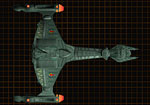 |
|
VOR'CHA - Heavy Battlecruiser |
The
Vor’cha-class “Battlecruiser” makes up the bulk of the
Klingon fleet. A powerful ship second only in size and
firepower to the mighty Negh’Var, the Vor’cha manages to
maintain its maneuverability despite its upgraded
posture. Due to its versatility, the Vor’cha is tasked
with numerous roles in the Klingon Empire. While it is
the primary assault vessel of the Klingon Military
during wartime, it is also equipped with a cloaking
device and advanced long-range sensor systems, allowing
it to be quite effective as an exploratory and
reconnaissance vessel.
Notable Vor’cha-class vessels include the I.K.S. B’Err,
which transported Klingon High Council leader K’mpec on
his final mission in 2367, and the I.K.S. Vor’nak,
commanded by General Tanas. |
| |
|
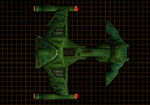 |
The
Fek’lhr-class is named after a mythical Klingon beast
who guards the gates of Gre-Thor, where dishonored Klingon warriors go after death. The vessel was designed
as a heavy attack escort vessel. Better armored and
mounted with better weapons than the smaller ships in
the military, the Fek’lhr is also capable of long-range
reconnaissance and scout duties thanks to its cloaking
device and advanced sensor package. The Fek’lhr is also
equipped with a modular equipment pod similar to that
found on the Federation’s Nebula-class. This allows the
vessel to be refitted quickly for other duties.
Notable Fek’lhr-class vessels include the I.K.S. Kosh,
which led the assault on Cantessa Prime during the
Klingon push toward Cardassia Prime in the Dominion War. |
| |
|
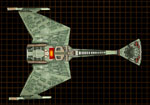 |
The
K’Tinga-class vessel has been in service in the Klingon
empire in one form or another for decades, even longer
than the dependable B’Rel-class “Bird of Prey.” The ship
has received constant upgrades and refits to keep it
current, and still serves many important functions in
the Empire today. The design is based on the original
Klingon D7 vessel. While certainly dependable in combat,
the K’Tinga is one of the only Klingon vessels adaptable
to exploratory and research use, as well. The vessel
serves many diplomatic functions and is a reliable light
escort ship.
Notable K’Tinga-class vessels include Kronos 1, which was
transporting Chancellor Gorkon to the Khitomer
Conference when he was assassinated in 2293 by sources
within the Klingon military. |
| |
|
 |
The
K’Vort-class “Destroyer” is a more advanced and upgraded
version of the smaller B’Rel-class “Frigate.” Like the
B’Rel l, it is capable of atmospheric flight and
planetary landings, as well as interstellar warp travel,
and is equipped with a standard Klingon cloaking device.
The K’Vort features more weapon mounts then the B’Rel,
and therefore requires a slightly larger crew to
operate. The added durability and offensive capabilities
of the craft make it a bit less maneuverable then the B’Rel. K’Vort-class vessels are primarily used as
fast-attack combat vessels and scout ships.
Notable K’Vort-class vessels include the I.K.S. Thraxis,
lost in the Battle of Meglar III in 2363. |
| |
|
 |
The
B’Rel-class “Frigate” also known simply as the “Bird of
Prey,” has been in service in the Klingon Empire for
over 80 years. The class has undergone several upgrades
and refits, but is still used as a major component of
the Klingon fleet. The ship is highly maneuverable,
requires a minimal crew to run at maximum combat
effectiveness, and carries very impressive firepower for
its small size. The B’Rel is capable of atmospheric
flight and planetary landings, as well as warp-speed
interstellar flight. The craft is also equipped with a
cloaking device, making it a very effective scout ship.
The hull design and general layout were used to create
the heavier K’Vort-class “Destroyer.”
Notable vessels in the class include the I.K.S. B’Redge,
which was instrumental in the defense of the Vartha
station during the brief Klingon civil war, and the
I.K.S. RanKuf. |
| |
|
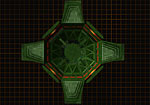 |
There are
three types of Klingon starbases. Each of them
have the same overall design, but differ in size and
purpose:
BASESTATION - A small, fixed installation.
Basestations are lightly armed and shielded, and are
usually constructed in areas where a permanent facility
is needed but a full combat-ready station is not.
STARBASE
- A large, fixed installation. Starbases serve to
establish control points in space and to provide major
staging areas from which to deploy starships. Starbases
are heavily armed, heavily protected, dangerous
facilities.
BATTLESTATION - Larger than a Basestation, the
Battlestation is more heavily armed and protected.
Battlestations are usually constructed in areas where
some combat may be expected, but the expense of a full
Starbase is not required. |
| |
|
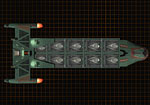 |
The common
freighter used in the Klingon Empire. |
| |
|
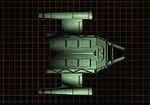 |
The
standard short ranged craft used by the Klingon Empire.
Shuttles can carry up to 6 personnel and are generally
used for short-range transport. |
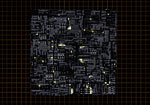 |
The
Cube is the primary vessel of the Borg Collective.
Massive in size, the Cube features a highly
decentralized design, making it difficult to effectively
damage in a combat situation. In addition, Cubes are
highly regenerative, able to repair damage to their armor very rapidly. Although lacking in maneuverability,
the Cube features highly advanced weapons capable of
destroying entire fleets of vessels. A typical Cube
features assimilation facilities capable of assimilating
an entire planet. The Cube is an awesome sight and a
feared opponent. |
 |
|
 |
The
Borg Pyramid functions as a “Frigate” vessel in the Borg
Collective. Its primary function is to assist the Cube
in reducing enemy resistance to assimilation. The Cube’s
massive size makes maneuvering to attack more agile
vessels a problem. Instead, the Borg utilize the Pyramid
for such purposes, as it is fast and highly
maneuverable, yet still features powerful Borg weapons. |
| |
|
 |
|
PYRAMID PRIME - Destroyer |
As
the Borg began encountering an ever greater number of
technologically advanced races, the Collective saw the
need to upgrade the combat potential of even their
smaller scout vessels. The Pyramid Prime features a
larger mass limit than the standard pyramid, allowing
greater latitude in selecting weapons and systems. In
addition, the Prime has more powerful standard engine
systems. The extra mass devoted to ship systems results
in a slight decrease in top speed and maneuverability. |
| |
|
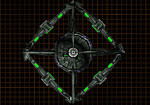 |
The Borg
Diamond’s main function is to scout areas for races and
technology to assimilate. Upgraded weapons systems and
high maneuverability allow it to avoid enemy resistance
if necessary and return to the Collective, so that
heavier assimilation forces may be dispatched. |
| |
|
 |
| DIAMOND
PRIME - Heavy Cruiser |
The
Diamond Prime is an upgraded version of the standard
Borg Diamond. While standard Borg design emphasizes a
balance between a vessel’s offensive capabilities and
its assimilation facilities, the rise of empires which
pose a legitimate threat to the Collective necessitated
a change in design. As a result, the Prime has more mass
available to devote to weapons and systems. It also
comes equipped with more powerful engine systems and
additional weapons. |
| |
|
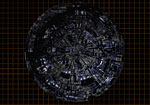 |
|
SPHERE - Heavy Battlecruiser |
The
Borg Sphere is second in size and power only to the
mighty Cube. Its primary function is to aid the Cube in
large-scale assimilations which require a high degree of
combat. The Sphere is more maneuverable than the Cube
and requires fewer resources, making it a reliable
support ship. In addition, the Sphere has its own
large-scale assimilation facilities, allowing it to
complete low-risk assimilations on its own if need be. |
| |
|
 |
| SPHERE
PRIME - Dreadnought |
As
they spread into the Alpha quadrant, the Borg began
encountering groups of technologically advanced races
that were capable of mounting more of a resistance to
forced assimilation. The Collective adapted by modifying
its vessels to carry more advanced systems and
firepower. The Sphere Prime is second only to the Cube
in sheer power. The Prime features more available mass
for weapons and systems, as well as a more powerful
standard engine and weapon loadout. Due to the increased
mass, the Sphere Prime is slightly less maneuverable
than the standard Sphere. |
| |
|
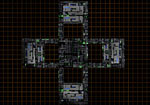 |
There are
three types of Borg starbases. Each of them have
the same overall design, but differ in size and purpose:
BASESTATION - A small, fixed installation.
Basestations are lightly armed and shielded, and are
usually constructed in areas where a permanent facility
is needed but a full combat-ready station is not.
STARBASE
- A large, fixed installation. Starbases serve to
establish control points in space and to provide major
staging areas from which to deploy starships. Starbases
are heavily armed, heavily protected, dangerous
facilities.
BATTLESTATION - Larger than a Basestation, the
Battlestation is more heavily armed and protected.
Battlestations are usually constructed in areas where
some combat may be expected, but the expense of a full
Starbase is not required. |
| |
|
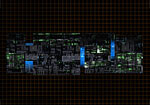 |
The
Cylinder is a freighter/transport vessel. |
| |
|
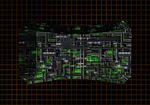 |
The
standard short ranged craft used by the Collective.
Shuttles can carry up to 6 drones and are generally used
for short-range transport. |
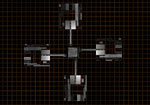 |
An
orbital ship building and refit facility used by all
races in the game. It has different variations
based upon how many docks it has. The one in the
picture has four docks.
|
 |
|
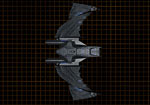 |
The
Scimitar is a new super battleship of Reman design. It
mounts the highest amount of firepower seen on a
starship, rivaling even that of a Borg Cube! |
| |
|
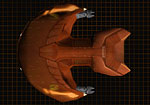 |
One
of the most common Ferengi battleships encountered.
It is relatively well armed and has plenty of space for
cargo. |
| |
|
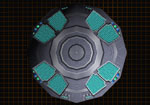 |
A
small, lightly-defended fixed installation normally used
as a sensor platform or small outpost. |
| |
|
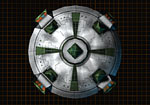 |
A
joint venture between the Federation and Klingon Empire
to develop a station that can detect cloaked vessels.
|
| |
|
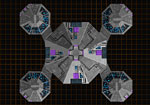 |
A neutral
station. |
| |
|
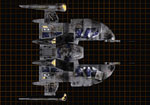 |
A
ship controlled by a rogue group of raiders. |
| |
|
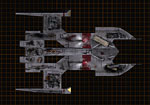 |
One
of the larger ships controlled by a rogue group of
raiders. |
|
|
|
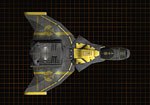 |
A small
attack ship armed with phasers.
|
|
|
|
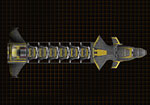 |
A
transport ship. |
|
|
|
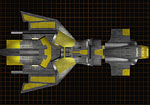 |
Larger than
the Rakelli attack ship, the light cruiser is well
shielded and armed. |


|
|
















































